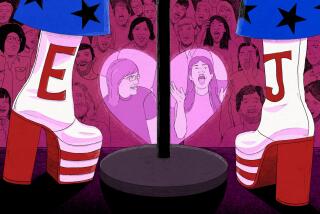POP MUSIC REVIEW : Saturday Nightâs All Right for an Understated Elton : John bounces back from personal turmoil in Dodger Stadium show with co-headliner Eric Clapton.
In 1975, Elton John was on top of the world, and in a pair of memorable performances he conquered the vastness of Dodger Stadium with extroverted showmanship and dazzling musical craft. His cultural celebrity only added to the charge.
In 1992, John is climbing back from career doldrums and personal turmoil, and in his return to the downtown ballpark on Saturday he conquered the vastness not with a larger-than-life persona but with an emotional focus that drew the audience into the reassuring embrace of his durable music.
John is a sentimentalist, and as a performer heâs always alert to the moment. That combination at one time might have led him to exaggerate the undercurrents of resurgence and recovery into a heightened--and false--emotionalism. But on Saturday, any sense of triumph or breakthrough remained unstated. That restraint and proportion typified both the form and content of the performance.
Following a set by fellow English veteran Eric Clapton--co-headliners on their four U.S. stadium collaborations, they were scheduled to switch positions at Sundayâs finale--John opened alone at his electric piano with âDonât Let the Sun Go Down on Me,â building the balladâs symphonic intensity at a measured pace.
A sequence of âIâm Still Standing,â âI Guess Thatâs Why They Call It the Bluesâ and âPhiladelphia Freedomâ kicked things into up-tempo gear, and while guest vocals and guitar from Clapton on the recent âRunaway Trainâ didnât set off sparks, the subsequent âBurn Down the Missionâ and âTiny Dancerâ got things moving again.
Johnâs five backing instrumentalists and three backup singers mounted a strong attack, and his voice has lost none of its suppleness. It might even have gained some richness, though it apparently has lost a little range, judging from the way he sidestepped the falsettos in âRocket Man.â
The show didnât run to perfection for its entire 2 1/2 hours. For a while things seemed to be slipping away from him, and even âDanielâ seemed alarmingly flat during a stretch in which he suddenly seemed adrift in slow material. John recovered with âFuneral for a Friend/Love Lies Bleeding,â and the show peaked with a version of Queenâs âThe Show Must Go On.â Again, John avoided the potential for bathos with a simple acknowledgment of Freddie Mercuryâs lyric of determination, written while he was dying of AIDS.
Johnâs encore was highlighted by a guest appearance by George Michael on a reprise of âDonât Let the Sun Go Down on Me,â a powerfully felt vocal on âCandle in the Windâ and a concluding solo version of âYour Songâ that John linked to his breakthrough L.A. debut 22 years ago.
The toned-down approach isnât new for John, and his old over-the-top flamboyance never even seemed to be considered, and certainly wasnât missed. His focus was entirely on the music, and the no-nonsense approach was as absorbing in its way as the old theatrics were entertaining.
In a two-hour set of his early blues rock and his later pop rock, Clapton showcased his usual instrumental prowess and personal dignity. His gospel- and blues-fueled rock sounded surprisingly good thundering out of center field, with a good deal of the dynamics and soulfulness intact.
More to Read
The biggest entertainment stories
Get our big stories about Hollywood, film, television, music, arts, culture and more right in your inbox as soon as they publish.
You may occasionally receive promotional content from the Los Angeles Times.










